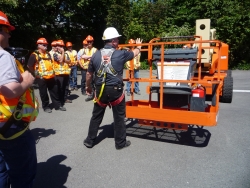It is encouraging to see the improvements in the attitudes and actions of workers, supervisors and employers toward safety since I entered the workforce back in the mid-1970s. Back then, safety was conveyed passively and almost never enforced to any effective degree. It was my experience that if you wanted to be safe, you had to ask for things like training and PPE, which was begrudgingly and often poorly distributed. This is largely not the case today as the increased development and enforcement of safety regulations over the years has raised the awareness of safety among employers which, in turn, has allowed them to realize many potential financial gains made possible through working safely. Likewise, employees who have realized that working safely is not merely a matter of following rules and avoiding discipline but a means to living their personal lives to the fullest by avoiding the devastating consequences of injury or disease suffered at work, are enjoying the core benefits of working safely.
 However, there is one link in the chain between employers and workers that in my opinion is lagging behind the others in terms of receiving the information and training needed to do their jobs properly, and that group is supervisors. Supervisors are often overlooked in the overall safety plan of many companies which creates a critical flaw that ultimately weakens the safety chain, often to the point of failure.
However, there is one link in the chain between employers and workers that in my opinion is lagging behind the others in terms of receiving the information and training needed to do their jobs properly, and that group is supervisors. Supervisors are often overlooked in the overall safety plan of many companies which creates a critical flaw that ultimately weakens the safety chain, often to the point of failure.
It’s not that Supervisors don’t get the information and training they need to keep themselves safe but that they don’t get the information and training needed to ensure that the workers under their watch are working safely. Hence the critical flaw that creates the opening for workers to work unsafely or otherwise contrary to any training received because their Supervisors lack the knowledge to recognize the situation much less correct it, as is their duty.
Recognizing this situation is one small step for employers but doing something about it is the one giant leap they must make if they expect to enjoy the benefits of a well implemented and maintained safety program. The key word here being maintained, in that it incorporates ongoing, sustained effort directed toward consistent and dedicated delivery, enforcement and improvement of the overall safety plan from every link in the chain, especially the Supervisors!
Supervisors must be involved in the safety plan. It is their duty and responsibility to ensure it is delivered, understood and carried out by every worker on their crew every hour of every day. To do that, they must be given every bit as much knowledge and training as their workers and the means to recognize, correct, reward and/or discipline workers who do not follow safe work procedures as per their training.
Wherever possible, Supervisors should be routed through the same training as their workers. The goal is to provide them with information and knowledge on how to properly and safely perform the work that the workers under their supervision perform. There is no need to evaluate their competence in job-specific tasks unless they are expected to perform such tasks. By partaking in this training, Supervisors are more able to actively and effectively supervise workers. Where it is not possible for Supervisors to partake in the training their workers do, some effort must be made to equip them with basic information on how and why workers are being trained to do their jobs. This basic information could be conveyed to Supervisors through abbreviated training sessions that do not include the practical hands-on components of full worker training sessions, briefing sessions where only safe work methods and procedures are reviewed or perhaps simplest of all, providing Supervisors with job specific checklists containing “must do” safety items that they could use as a quick reference while monitoring workers.
There is no doubt the accessibility, quality and general buy-in to safety and safety training throughout all levels of business and industry has increased exponentially over what it was in the past. Respectively, employers and workers alike are now enjoying the numerous benefits that may be realized through working safely from corporate financial efficiency to the most precious asset of all, quality of life if not life itself. However, there is work to be done to improve the strength of the safety chain which can be achieved relatively easily by including Supervisors in the mix and providing them with job/task specific knowledge and empowering them with the means to ensure that safety training marks the beginning of the process, not the end.
Rob Vetter
Director of Training
IVES Training Group
Did you enjoy this article? Sign up for our newsletter to receive more like this!